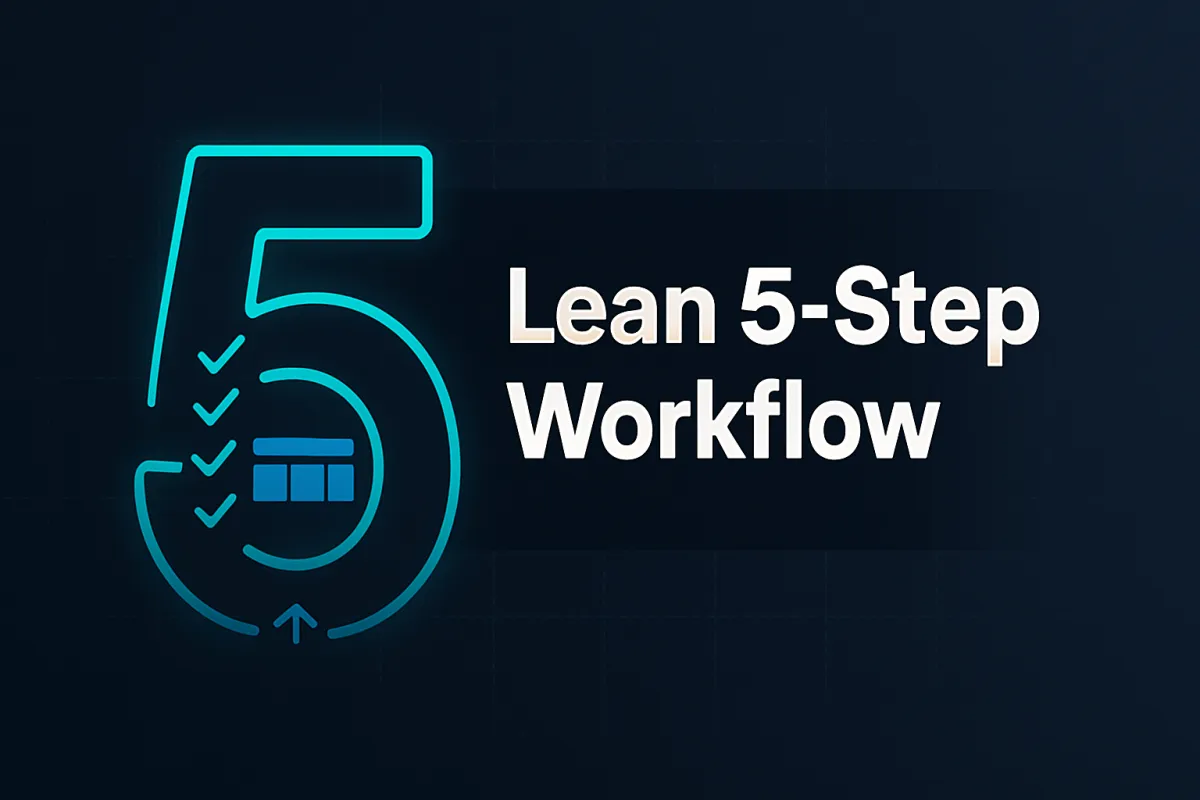LinkedIn Ghostwriter Workflow: A Lean 5-Step Pipeline from Client Intake to Quality Check
The one-person LinkedIn ghostwriting process to manage multiple executive clients without chaos

Introduction
LinkedIn ghostwriting for executives gets messy without a system. With multiple clients, it's easy to lose track of ideas, voice notes, approvals, and deadlines. That leads to mistakes and weekend rewrites. A lean content pipeline turns this into a repeatable workflow that works at scale.
Proof it works: In a case study by Column Content, executive "Beth" went from inconsistent posting to six straight months of ghostwritten content. Results: profile views up 35%, followers up 53%, and engagement up 41%. That led to 22% more website traffic from LinkedIn and 19% more revenue from LinkedIn leads. LinkedIn itself confirms weekly posting can bring up to 4× more views (LinkedIn). To get those results without burning out, you need a structured workflow.
The lean pipeline at a glance
Brief, goals, tone, brand and audience notes. Set success metrics.
Topics, briefs, calendar, sources, SME inputs, workflow status.
First draft, SME review, tracked edits, approvals, final copy.
Fact check, links, style, SEO, accessibility, final polish.
Publish, measure, updates, refresh cycles, SLAs and retainers.
Useful if you want the bigger-picture business case for why a disciplined workflow compounds into premium retainers: LinkedIn Ghostwriting for Executives - The Hidden $10K MRR Solo-Service Trend
1) Client Intake & Voice Alignment
The goal is a clear client brief that defines goals, audience, voice, and logistics. This ensures every post sounds like the client and meets their needs.
Build your ghostwriting client intake form around:
- Goals: leads, recruiting, thought leadership, or investor visibility.
- Audience: who the content must resonate with.
- Voice/Tone: casual or formal, storytelling or data-first, client phrases, off-limits topics.
- Signature stories and POVs: anecdotes, beliefs, frameworks to reuse.
- Logistics: posting cadence, draft format, who approves, expected turnaround times.
Create a one-page brief with bio, audience, tone, messaging, and dos/don'ts. A simple home for this is a Notion page per client.
2) Content Planning & Organization
You need a simple calendar and tracker, one per client, to avoid last-minute scrambles and lost ideas.
Set up a content calendar and Kanban:
- Use a board (in Notion) with columns: Ideas → In Draft → Sent to Client → Approved → Scheduled/Posted.
- Assign target publish dates and plan 1–2 weeks ahead to batch writing.
- Capture ideas continuously: anecdotes, call snippets, industry trends, timely events. Keep them in an Ideas column.
- Keep it lean. Some tools handle reminders so you always know what's next (workflow tips).
Pro tip: Share a monthly calendar view with clients so changes happen at the plan stage, not during revisions.
SEO Content Briefs in 2025: Solo Founder's 30-Minute Intent-First Workflow
3) Drafting, Revisions & Collaboration
Keep the client brief open while you write. Many ghostwriters skim a transcript or past posts before drafting to capture the client's voice. Keep posts simple: strong hook, short paragraphs, clear takeaway.
Make collaboration easy:
- Send drafts in the agreed format with the intended publish date.
- Ask focused questions like "Is this anecdote accurate?"
- Set revision limits: usually one or two rounds. Ask clarifying questions if feedback is vague.
- Protect scope: handle last-minute extras by reprioritizing or adjusting budget/timeline, not by derailing the schedule.
4) Quality Control (QA)
Run a standard QA checklist before posting. This prevents errors and off-brand tone.
Ghostwriting QA checklist:
- Voice match: read as the client. Does it sound like them?
- Requested details: are all mentions, tags, and disclaimers included?
- Clarity: one core idea with logical flow.
- Proofreading: no typos or grammar errors. QuillBot can help polish phrasing. Always do a final read (quality-control tip).
- Names and links: check spellings, job titles, and URLs.
- Formatting and hashtags: add line breaks, keep hashtags relevant, and confirm images or documents are ready.
This five-minute check prevents public mistakes and last-second rewrites.
5) Managing Multiple Clients & Maintenance
Sustainability comes from structure.
- Compartmentalize: dedicate time blocks to each client, or batch by task.
- Use a unified view: track deadlines across clients to prevent clashes.
- Train the process: ask clients to drop ideas into shared spaces instead of urgent DMs. Define response times and lead times.
- Keep it lean: standardize templates and reuse what works. Only add tools that clearly save time.
Conclusion
A ghostwriter workflow turns scattered tasks into a calm, repeatable system. Align the client's voice, plan ahead, draft with structure, check quality, and protect your schedule. This leads to consistent posts that drive real outcomes, like in Column Content's case study. With this workflow, one person can deliver consistent posts while keeping every client's voice intact.
FAQs
What is LinkedIn ghostwriting and how does it work?
It's writing LinkedIn posts for an executive. You interview them, plan topics, draft in their voice, revise with feedback, and publish under their name.
How do you become a LinkedIn ghostwriter?
Show writing samples, focus on industries you know, and pitch executives who need consistent content. Then run a workflow like this to deliver reliably.
How much do LinkedIn ghostwriters charge?
Rates vary by experience and scope. Newer ghostwriters might earn a few hundred dollars a month. Experienced ones often charge $500+ per post or $2,000-$5,000+ monthly retainers.
What should a ghostwriting client intake form include?
Client goals, target audience, voice/tone examples, signature stories, topics to prioritize, logistics for cadence and approvals, and compliance boundaries.
How can ghostwriters maintain the client's voice consistently?
Collect writing samples, record and transcribe calls, create a mini style guide, and read drafts aloud as if you are the client.
Should a ghostwriter also post on LinkedIn for the client?
Often yes. Many executives prefer you to post once approved. Confirm access and security during onboarding.
How should revisions and approvals be handled?
Agree on one to two rounds of revisions. Ask for consolidated feedback each round. Tie approval deadlines to publishing dates to keep posts moving.





